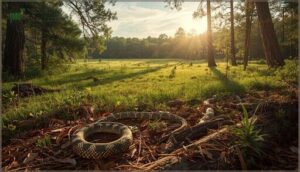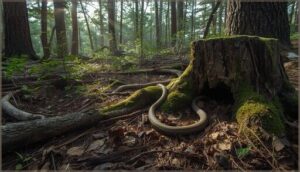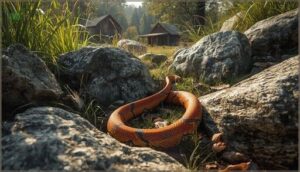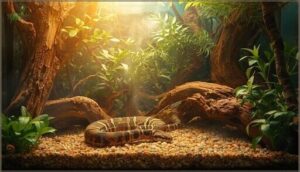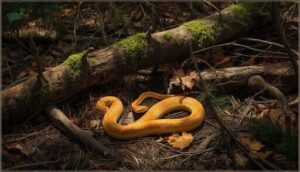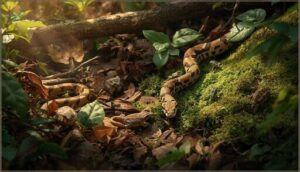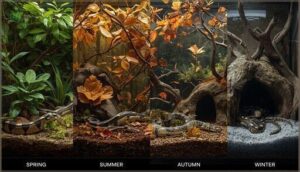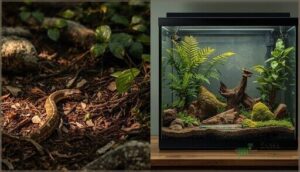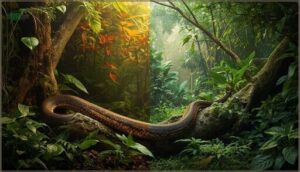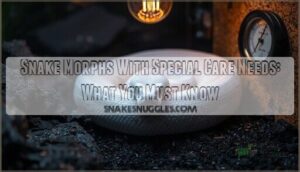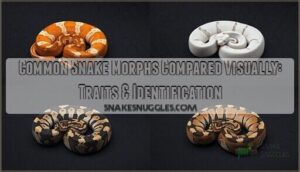This site is supported by our readers. We may earn a commission, at no cost to you, if you purchase through links.
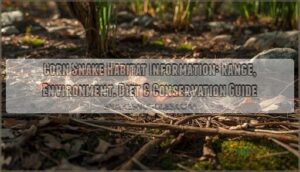
Habitat defines every aspect of a corn snake’s life, from nighttime forays through leaf litter to the careful search for sun-warmed shelter.
Understanding corn snake habitat information isn’t just for herpetologists; it’s the cornerstone for anyone keen on keeping these secretive creatures protected, healthy, and thriving in a world that won’t stop shifting.
Table Of Contents
- Key Takeaways
- Corn Snake Natural Habitat Overview
- Geographic Range and Distribution
- Forest and Wetland Environments
- Rocky Areas and Human Habitation
- Climate and Environmental Needs
- Shelter and Cover in The Wild
- Diet and Prey Availability in Habitat
- Seasonal Habitat Use and Behavior
- Differences in Wild Vs Captive Habitats
- Conservation and Human Impact
- Frequently Asked Questions (FAQs)
- What kind of habitat do corn snakes need?
- What is the best environment for a corn snake?
- Where do most corn snakes live?
- What is the best enclosure for a corn snake?
- What affects corn snake migration patterns?
- How do humans impact local ecosystems?
- Are corn snakes good for farms?
- Can corn snakes live in urban areas?
- Do corn snakes make good hunting partners?
- How do corn snakes interact with other wildlife?
- Conclusion
Key Takeaways
- Corn snakes thrive in diverse southeastern U.S. habitats, including forests, wetlands, rocky areas, and even suburban spaces, relying on cover and prey for survival.
- Stable populations depend on connected, healthy habitats; fragmentation and loss pose the biggest threats to their long-term stability.
- Proper shelter, climate, and diet are essential for both wild and captive corn snakes, with habitat features like leaf litter, burrows, and humidity playing key roles.
- Conservation efforts, such as habitat restoration and urban wildlife management, are crucial for supporting corn snake populations and reducing human-wildlife conflict.
Corn Snake Natural Habitat Overview
Corn snakes call a variety of southeastern landscapes home, each offering its own mix of cover and climate. You’ll find them thriving in places that suit their natural instincts and physical needs. Let’s look at the main habitats where these snakes feel most at ease.
Native Southeastern US Regions
Across the southeastern United States, corn snakes thrive in a patchwork of habitats, from Florida’s Coastal Plain Abundance to the Disjunct Kentucky Population. State Population Densities peak in Florida and Georgia, though Habitat Fragmentation Impact is evident elsewhere.
Corn snakes, also known as red rat snakes, are commonly found in this region. Regional Legal Status varies—Georgia offers protection, while other states lag—making Habitat Preservation essential for the species’ continued Distribution and stability.
Typical Ecosystems and Landscapes
You’ll notice corn snake habitat diversity stretches from grassy plains with loose, sandy soils to mature pine-oak forests and rocky hillsides. These landscapes, shaped by biome influence and regional variations, support thriving ecosystem health and wildlife ecology.
Landscape connectivity—think wetlands meeting forest edges—keeps populations stable. Corn snakes are also known to thrive in suburban areas near human homes.
That’s why habitat preservation remains essential for maintaining corn snake abundance throughout their range.
Geographic Range and Distribution
If you’re wondering where corn snakes call home, their range stretches across much of the southeastern United States. They favor certain elevations and microhabitats, adapting to a variety of environments.
Let’s take a closer look at the specific regions and conditions where you’ll find them.
States Where Corn Snakes Are Found
You’ll find corn snakes throughout the southeastern United States, with thriving populations in Florida, Georgia, Alabama, and South Carolina. Their range boundaries extend from southern New Jersey to the Florida Keys and west to Louisiana.
State populations vary considerably, with some regions like New Jersey’s Pine Barrens facing conservation status concerns due to habitat variations. Introduced populations also exist in the Caribbean.
Elevation and Microhabitat Preferences
While corn snakes range from sea level to 1,800 meters, you’ll commonly spot them below 600 meters elevation. Their microhabitat selection reveals a clear pattern: they favor oak-pine forests on shale hills, especially second-growth woodlands with edge habitat nearby.
Shelter usage centers on rodent burrows, log piles, and rocky crevices, where vegetative cover and debris provide essential refuge. Wetland proximity matters too—many individuals forage within 100 meters of water sources.
Forest and Wetland Environments
Corn snakes don’t just stick to one type of landscape—they’re at home in several kinds of forested and wetland environments across the Southeast. These habitats offer the perfect mix of cover, prey, and moisture that corn snakes need to thrive.
Let’s look at the specific ecosystems where you’re most likely to find them.
Pine and Oak Forests
Pine and oak forests in the southeastern United States create ideal ecosystems for corn snakes. You’ll find them thriving in mature woodlands where habitat fragmentation hasn’t disrupted forest structure.
These forest microhabitats—decaying logs, stump holes, and leaf litter—provide excellent cover and support prey abundance with mice and voles.
Conservation efforts focus on preserving these important corn snake habitat areas.
Swamps, Marshes, and Wetlands
In wetland habitats like swamps and marshes, you’d see the secrets of corn snake survival unfold. Dense underbrush, moist leaf litter, and downed logs offer prime microhabitat preferences, supporting stable humidity conditions.
Wetland distribution attracts abundant prey availability, but conservation threats like habitat loss and fragmentation demand vigilant wildlife conservation to sustain these notable members of southeastern fauna and ecosystems.
Rocky Areas and Human Habitation
Corn snakes are just as comfortable tucked among rocky outcrops as they’re slipping into old barns or sheds. These snakes make use of all sorts of hiding spots, both in the wild and around people.
Here are a few enclosure setups that echo the places they call home.
Rocky Outcrops and Hillsides
In rocky terrain across the southeastern United States, you see the artistry of hillside ecology at work. Outcrop features—crevices, boulders, and ledges—become prime snake shelter, shaping microhabitat use for corn snakes.
These rugged ecosystems offer stable humidity and temperature, allowing you to glimpse reptile biology in action as these snakes blend expertly into their environment.
Barns, Abandoned Buildings, and Urban Spaces
Ever wonder how Urban Snake Habitats shape Abandoned Building Ecology in the southeastern United States? You’ll find these snakes thriving in barns and vacant structures, drawn by rodent-rich ecosystems and stable microclimates.
Barn Conservation and Urban Wildlife Management play essential roles in reducing Human Snake Conflict, supporting wildlife conservation, and maintaining healthy populations amid ongoing habitat changes and urban expansion.
Climate and Environmental Needs
Creating the right environment for your corn snake starts with understanding its climate needs. Temperature, humidity, and airflow all play a critical role in keeping these snakes healthy.
Here’s what to look for when setting up their habitat.
Temperature Requirements
How well do you manage your habitat’s temperature? For corn snakes, a precise thermal gradient is essential—think basking spots warmed by regulated heat sources on one side, with a cooler retreat opposite. Accurate temperature monitoring lets your snake thermoregulate instinctively.
In reptile care, this careful balance safeguards digestion, activity, and health, reflecting conditions found in their natural environment.
Humidity and Ventilation
Striking the right humidity balance in a corn snake terrarium is like tuning a fine instrument—too dry and shedding suffers, too damp and problems take root. Reliable Humidity Control and Ventilation Systems, including daily misting and well-placed vents, keep Air Quality healthy and support good Moisture Management. Climate Regulation in your reptile enclosure is about active, responsive care:
- Use a digital hygrometer for real-time monitoring
- Provide a humid hide filled with moistened sphagnum moss
- Layer substrate for natural Moisture Management
- Verify vents allow gentle airflow without excess drying
Shelter and Cover in The Wild
Regarding staying hidden in the wild, corn snakes know how to make the most of their surroundings. Shelter isn’t just about safety—it’s their ticket to warmth, comfort, and avoiding predators.
Here’s what you’ll find them using for cover in their natural habitat.
Natural Hiding Spots
When you picture corn snakes in their natural habitat, you might notice how they expertly use shelter characteristics to remain concealed. Leaf litter, stump holes, and bark offer ideal microhabitat selection, supporting both seasonal brumation and predator avoidance. Their camouflage adaptations aren’t just for show—they’re a key strategy in a diverse range of ecosystems and wildlife settings.
| Hiding Spot | Predator Avoidance | Seasonal Use |
|---|---|---|
| Loose bark/logs | High | Year-round |
| Stump holes | Moderate | Winter brumation |
| Leaf litter | Variable | Summer, Autumn |
| Abandoned barns | High | Spring, Autumn |
Use of Burrows and Vegetation
Blending into dense ecosystems, corn snakes put as much trust in Burrow Microclimates as any cloak of Vegetation Camouflage. You’ll see Shelter Overlap where roots, brush, and inherited burrows meet, supporting Habitat Stability and sharp Predation Avoidance.
These habitat features provide:
- Cool, stable temperatures
- Moist refuge during drought
- Concealment from predators
- Safer nesting spots
Diet and Prey Availability in Habitat
Understanding what corn snakes eat in the wild helps you create a habitat that feels natural and secure. Their environment offers a variety of prey, shaping how they hunt and thrive.
Here’s a closer look at the main food sources you’ll want to think about for their enclosure.
Small Mammals and Birds
When you consider the diet of corn snakes across southeastern ecosystems, small mammals and birds dominate prey biomass. Rodents like cotton rats drive nutritional intake, while nest predation on chicks increases during spring. Their habitat shapes seasonal consumption, and precise capture methods—such as constriction—align with energetic value needs.
Here’s a quick reference for their wild prey habits:
| Prey Type | Capture Methods | Seasonal Consumption |
|---|---|---|
| Rodents | Constriction | Year-round, dominant |
| Bird Nestlings | Climbing, coil | Peaks April–June |
| Mammals/Birds | Ambush | Shifts with availability |
Lizards, Frogs, and Other Prey
While rodents anchor a corn snake’s diet, young snakes—especially in forest or marshy habitats—lean heavily on lizards and frogs. This juvenile diet shapes their growth and survival, with prey diversity shifting as they mature. In your local ecosystem, you might find juveniles feeding on:
- Treefrogs after spring rains
- Skinks in sandy woodlands
- Small geckos near urban habitats
Seasonal Habitat Use and Behavior
Corn snakes adjust their routines throughout the year, shifting where they spend time and how they behave. Different seasons bring changes in temperature, humidity, and shelter needs.
Here’s a look at the types of enclosures that can support their natural rhythms.
Nocturnal Activity Patterns
When dusk falls, corn snakes slip into action, guided by subtle sensory cues and shifting temperatures. In their habitat, nocturnal activity spikes during summer warmth—when the day’s heat pushes them underground.
Their hunting success hinges on timing and prey selection, adapting to humidity and moonlight. Even in captivity, proper light cycles are key for natural snake behavior and appropriate corn snake behavior outcomes.
Seasonal Movements and Reproduction
Come spring, corn snakes emerge from brumation, drawn into mating rituals as rising temperatures signal a new season. Males roam widely, seeking receptive females, while clutch size—ranging from 10 to 30 eggs—reflects the habitat’s quality and available diet.
Once eggs hatch, hatchling independence is immediate. Habitat disruption can alter reproduction cycles, emphasizing the snake habitat’s delicate balance.
Differences in Wild Vs Captive Habitats
Creating a home for a corn snake is a different challenge compared to what they experience in the wild. Captive habitats need to provide security, comfort, and a bit of natural complexity.
Here’s how various enclosures measure up to those needs.
Enclosure Size and Setup
If you’re aiming for a reptile enclosure that truly meets a corn snake’s needs, think bigger—adults thrive in terrariums at least 48” × 24” × 24”. Strong lids and secure hides are non-negotiable.
| Minimum Dimensions | Substrate Depth | Hides Required |
|---|---|---|
| 4’×2’×2’ | 3–4 inches | Two or more |
Thoughtful terrarium setup and design improve welfare and safety.
Substrate, Enrichment, and Environmental Control
Think of terrarium design as recreating a living ecosystem. Bioactive substrates offer natural humidity control and support burrowing, while enrichment benefits come from climbing branches and leaf litter—your snake’s gym and playground. Temperature gradients promote healthy digestion; waste management clears what nature would break down. Every detail—substrate, structure, and control—brings captive habitat closer to what wild corn snakes enjoy.
| Feature | Practical Example |
|---|---|
| Enrichment Benefits | Climbing vines, leaf litter |
| Waste Management | Bioactive substrate cleanup |
Conservation and Human Impact
Caring for corn snakes goes beyond meeting their daily needs—it also means understanding how our choices affect their future. Human activity can shape where these snakes thrive, and even small changes to their habitat can have lasting effects.
To help you make the best choices, here are the most practical enclosure options available.
Habitat Loss and Fragmentation
Habitat loss and fragmentation strike at the core of corn snake survival. As ecosystems disappear—by 30% since 2000—your local wildlife faces genetic isolation, prey reduction, and microclimate stress. Imagine their world shrinking each year.
Habitat loss and fragmentation steadily shrink the world of corn snakes, isolating populations and threatening their survival
Consider three lasting impacts:
- Connectivity fractures wildlife corridors.
- Fragmented habitats limit hunting and shelter.
- Isolated populations risk genetic bottlenecks.
Population Stability and Conservation Efforts
Just how resilient are corn snake populations? The IUCN Status is “Least Concern”—thanks in part to controlled Breeding Programs, targeted Habitat Restoration, and threat mitigation strategies. Conservation actions rely on insights from genetic lineages, ecosystem management, and biodiversity protection efforts. Each move in wildlife and conservation strategies keeps these adaptable snakes thriving across southeastern landscapes.
| Conservation Measure | Outcome |
|---|---|
| IUCN Status | Least Concern |
| Breeding Programs | Stable captive populations |
| Habitat Restoration | Over 5,000 acres restored (FL) |
| Genetic Lineages | Guides targeted management |
| Threat Mitigation | Reduced human-caused mortality |
Frequently Asked Questions (FAQs)
What kind of habitat do corn snakes need?
You want your corn snake’s habitat to mimic the wild—think warm days, cool retreats, and dappled cover.
Ideal temperature and humidity levels support healthy brumation habits, shelter from natural predators, and safeguard against emerging habitat threats.
What is the best environment for a corn snake?
The best environment for a corn snake balances ideal temperature and humidity, a spacious enclosure, diverse substrate options, and meaningful enrichment.
This combination mirrors natural habitat complexity, supporting the snake’s overall health, behavior, and daily physiological needs.
Where do most corn snakes live?
You’ll find most corn snakes calling the southeastern U.S. home, with the highest habitat density and regional abundance in Florida.
Their key habitats include forests, fields, and barns—though microhabitat selection even brings them beneath houses or inside abandoned buildings.
What is the best enclosure for a corn snake?
Secure, spacious setups support your snake’s style—choose a terrarium or reptile enclosure at least 48”x24”x24”.
Prioritize deep cage bedding (3–4” of appropriate substrate material), a reliable temperature gradient, steady humidity control, and cross ventilation for proper habitat creation.
What affects corn snake migration patterns?
Temperature gradients, prey distribution, and shelter availability drive corn snake movement patterns. Seasonal changes trigger breeding migrations, while habitat fragmentation disrupts natural corridors—impacting species preservation and highlighting conservation needs in southeastern ecosystems.
How do humans impact local ecosystems?
Like ripples spreading from a single stone, human activities trigger ecosystem disruption through habitat destruction, pollution effects, and climate shift. Agriculture, urbanization, and resource exploitation drive biodiversity decline, demanding urgent wildlife conservation and ecological adaptation strategies.
Are corn snakes good for farms?
Yes, corn snakes benefit farms by providing natural pest control. They reduce rodent populations by up to 60%, lowering chemical use and supporting agricultural sustainability.
Through ecological balance and habitat conservation, these beneficial constrictors and reptiles play a vital role in maintaining healthy farm ecosystems.
Can corn snakes live in urban areas?
Yes, corn snakes can adapt to urban edges and suburbs where shelter and rodent prey remain abundant. However, habitat fragmentation and road mortality reduce their numbers in heavily developed areas, making conservation and urban planning essential.
Do corn snakes make good hunting partners?
Though corn snakes excel at prey control in their habitat, they’re solitary hunters by nature—no documented hunting partnerships exist.
Their ecosystem role involves controlling pests independently, not through human collaboration or coordinated animal behavior.
How do corn snakes interact with other wildlife?
Corn snakes play a crucial role in predator-prey dynamics by controlling small mammal populations, while also practicing competition avoidance with other snakes.
They exist as both predator and prey, contributing to ecosystem pest-control and forming indirect symbiosis, particularly in areas where habitat alteration impacts local wildlife.
Conclusion
A corn snake’s habitat can seem as intricate as an ancient, living labyrinth—each twist and turn supporting countless unseen dramas. Understanding corn snake habitat information carves a pathway through that complexity, illuminating the interplay between land, climate, and survival.
If you listen closely, the quiet resilience of these snakes reveals important lessons: adaptation stems from knowing your home’s story, and even the most unassuming corners of the wild are alive with possibility worth studying, protecting, and respecting.

